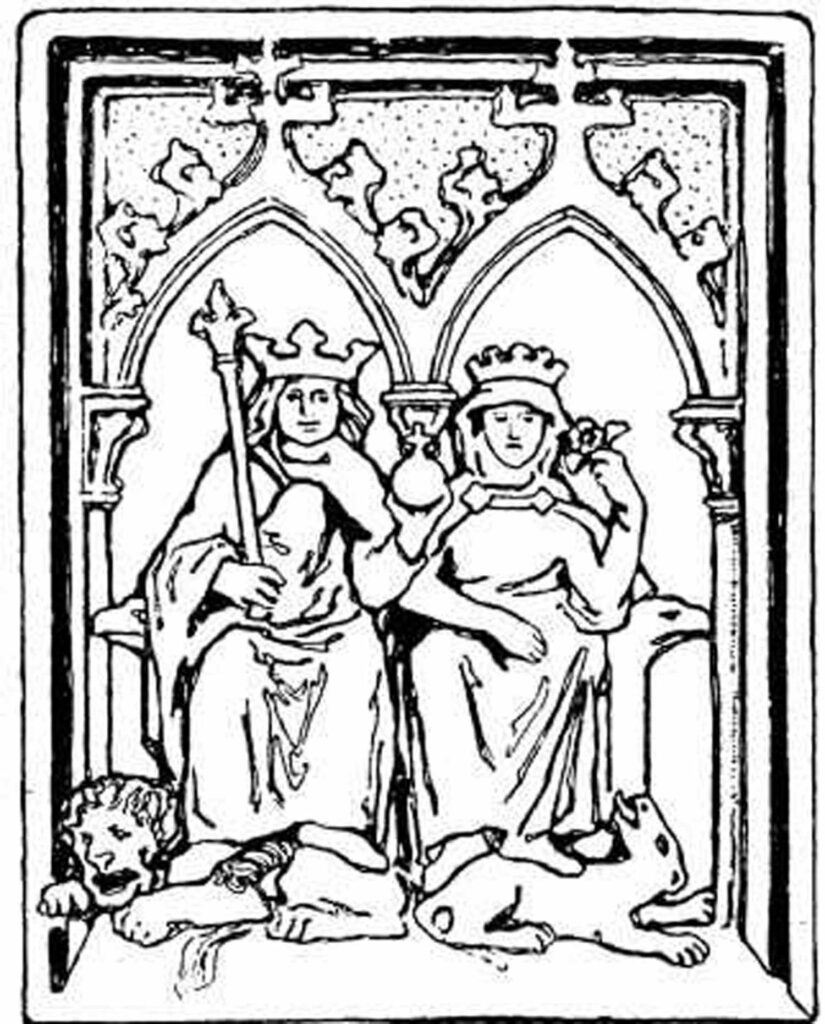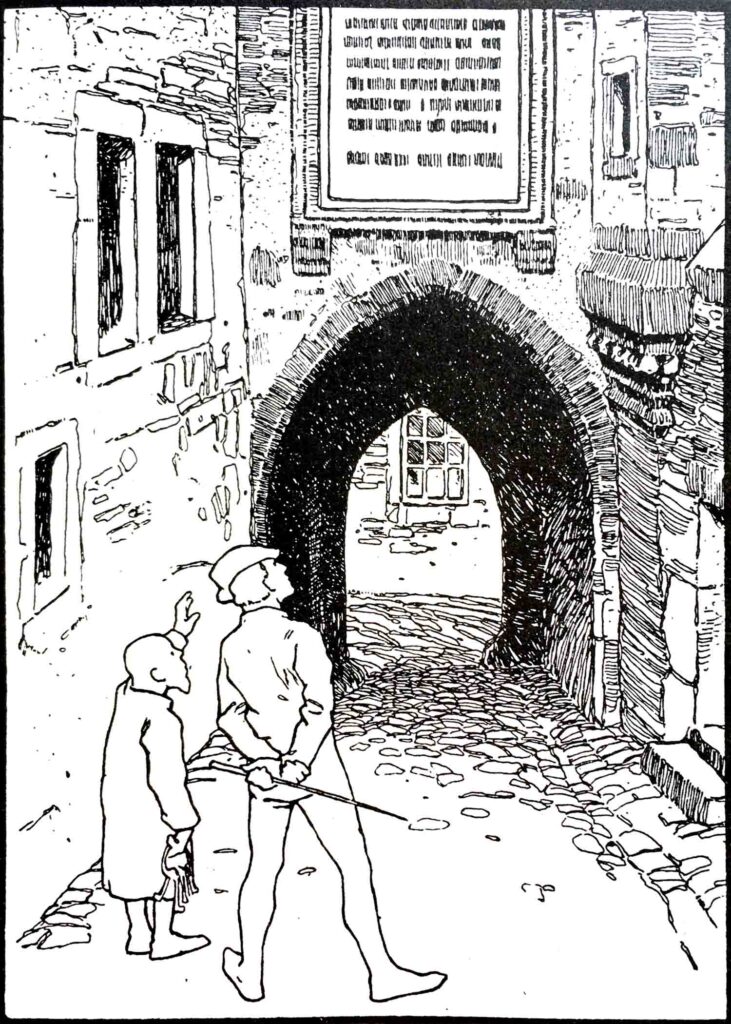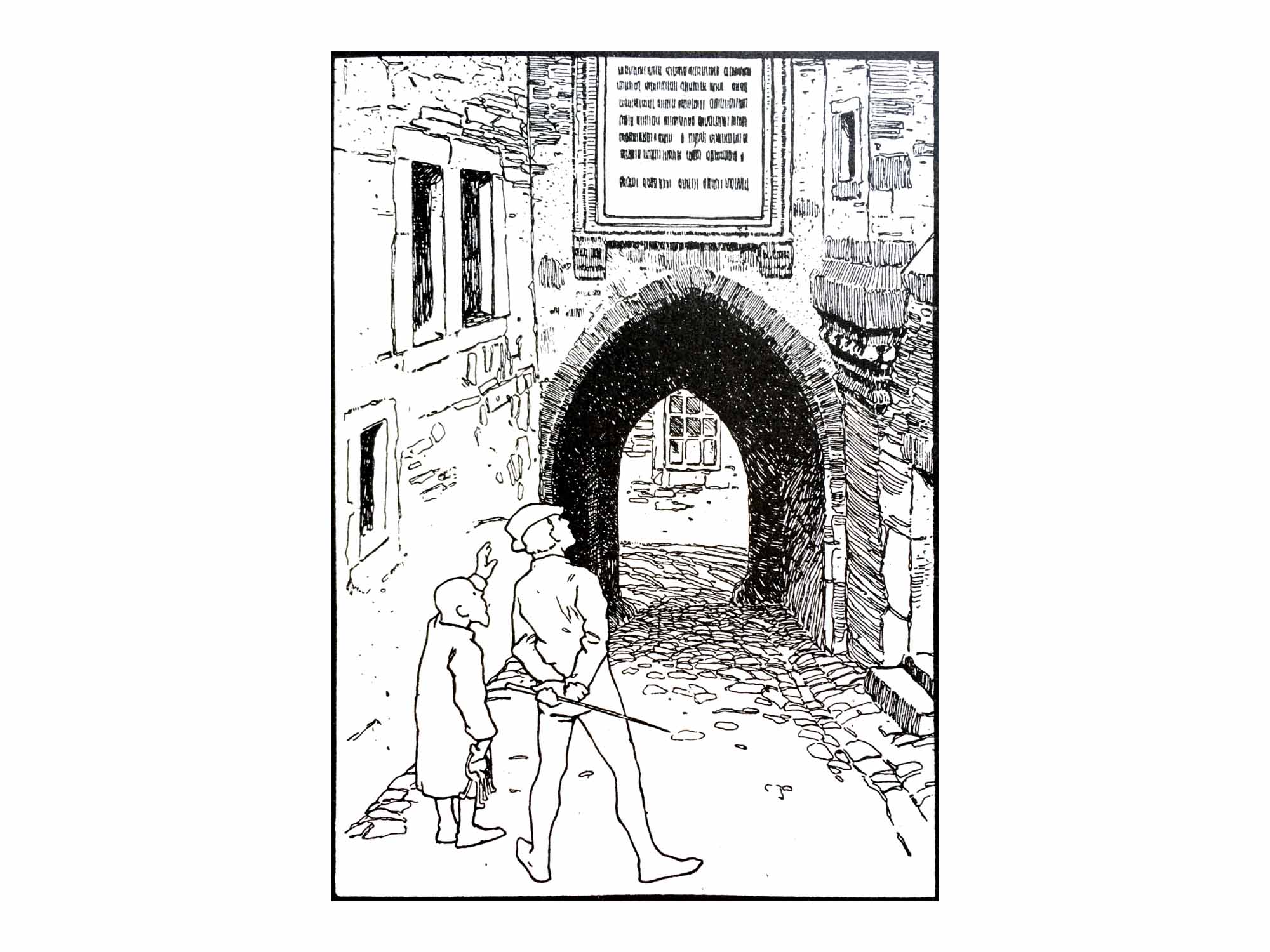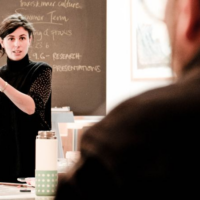Fairy tales are a path of thinking with the heart: living pictures that carry us beyond the sensory world and unite thinking and willing. They offer a contribution towards intuitive living.
When we hear phrases like “living thinking,” “artistic thinking,” or “imaginative/intuitive thinking,” they sound strange at first. However, it is possible to develop our thinking so that it becomes independent of our usual ties to the external world. By raising our thinking up to the sphere of intuition and drawing out an impulse for action, we step into a space of freedom.
I try to form pictures of my thoughts and goals that are similar to those in fairy tales. I let the essence or being of the subject matter itself speak alongside my own personal viewpoints. In this way, the being itself is experienced in the context of neighboring themes. I call this way of thinking “heart thinking.” It is fully alive in fairy tales and folk tales. Heart thinking is not just about intellectually mastering external reality but also about imagination and devotion. It is not about intellectual analysis but about letting ourselves be guided by our sense of truth to bring the goal we are striving towards into reality by way of our thinking and willing.
The King’s Son
The king and the queen wear crowns. When we consider the picture of the origin of the king’s son, we are not only pointed towards the union of a man and a woman but also towards the spirit. The son’s spirit, soul, and body arose from the light, from the realm of true love. This love walks beside him along every path. Even when he faces hardship, he is loved and helped by this love. He now has the task to not only let this love guide him to his goal but also to bring love to all his encounters with the world and all human beings. Here, ideas become ideals. Through seven stages (which are always present in an “archetypal fairytale”), the common, everyday understanding of the main character, the hero, is expanded, and, thereby, love and wisdom become more and more real, more present in our hero. The hero’s origin itself leads him onto the next stage. He leaves the home of his parents. He lets go of the old and seizes the new. He now wants to make his goal, his aim, into a reality, to manifest his ideal.
In the fairy tale of “The Queen Bee,” the hero, Simpleton, goes in search of his two older brothers. When he finds them, they mock him (even though they live in wretched circumstances) because, being “older,” they are “sensible,” and he, being “younger,” is a fool. At the beginning of the tale we aren’t told yet that our hero is actually looking for his bride. His path leads him on further, and we soon find ourselves at a third archetypal picture. Simpleton helps his older brothers by showing them that they should leave ants alone, they should not catch and roast the ducks on the lake, and they should not smoke bees out of their hives. He helps them and then continues on his own way. The brothers follow him. In a fourth archetypal picture, the real power of the “I” reveals itself: Simpleton passes three tests and saves the castle. His two brothers can only participate in the first test, which they both fail. They are too greedy and self-centered to pass on to further trials. Since our hero showed love for the animals (the ants, ducks, and bees), they now give to him in return. In the fourth archetypal phase, the animals help him pass his trials—finding the pearls, finding the key in the lake, and finding the youngest and dearest daughter of the king. The animals he has helped then help him find his bride. Simpleton now recognizes his true bride, and here, in the seventh stage, the wedding takes place. The fifth and sixth stages, the return to and arrival at the castle, are skipped in this fairy tale. (In others, the fourth stage of the trials is followed by a return to the castle with the wrong bride, which causes new problems; then, a fulfilled arrival with the right bride; and, on the seventh stage, the wedding). As the hero searches for a feminine being, his bride (meaning that he searches within himself, his own soul), he undergoes various transformations. In the end, there is the perfection and culmination of love and royal wisdom.
For the person who seeks their true self and finds it in the picture of the wedding, it is not only a matter of outwardly getting to know another person. Above all, it is a matter of establishing a relationship with them, with their real being. “True human love is rooted in spirit. . . . Wherever love is rightly proclaimed and rightly received; it will always give impulses that prepare the true logic of the heart. The logic of thinking is compatible with the strongest egoism. The logic of the heart is capable of gradually overcoming all egoism and brings all human beings to be participants in a human community.” (R. Steiner, Macrocosm and Microcosm, CW 119, lecture in Vienna on Mar. 31, 1910)
Imagination Made Real
An essential step in the development of heart thinking is the development of our higher feeling, what in German is called the Gemüt. It is here that, again and again, through the evolution of humanity, the foundations for a true human culture have been laid. Art and imagination play an important role. How can an idea that, at first, is merely intellectual be raised up to an ideal? How can we develop the powers of higher feeling? How can we develop our senses? Cultivate wonder, devotion, and awe? How will we be able to bring an idea vividly before us, to develop our imagination to the point where it can reveal the character of an idea or a human being? Imagination can open up the full reality of an idea by making us aware of how the idea would intervene in life should we actually want to make it a reality. The imagination tries to open up the character of the idea, showing how the idea affects life. It supplies our thinking with new facts that were not available before. Subsequently, the conscience can offer advice as to whether the new facts identify with the idea correctly or whether we are to reject these inwardly perceived phenomena as they are not in correct relation with the idea but, perhaps, a delusional fantasy.
In fairy tales and folk tales, this process arises from the life of thought from which the tale emerged. Thus, the end of a tale is always good. Good solutions are always found. In “The Queen Bee,” the two older brothers mock the younger one, but Simpleton’s love for them wins them over in the end. His love for the animals also brings about the fact that they help him in return. By developing his imaginative thinking, Simpleton is able to come closer and closer to the beings of his brothers, the animals, and to his own true nature. In the end, there is a union, the wedding with the king’s daughter, and the unification of love and royal wisdom. Now, the hero can master all situations. He becomes the supreme servant.

Integration
Are fairy tales depictions of the process of integration that occurs within individuals and humanity as a whole? Might this process have to do, above all, with the power of the “I”? Could integration have something to do with the internalization of the Christ impulse? Could “integration” mean integrating the invisible human being within the individual?
Classic Central European fairy tales teach us to develop interest in the being of the world and in the human being. Try to perfect yourself; try to become whole! The aim of life is not only death but resurrection, and resurrection begins in overcoming intellectual thinking, greed, and destructiveness. Thinking is to become essential; it must learn to concern itself with beings and essences. This is why we want to develop a lively interest and learn to think with our hearts.
The fairy tale “The Three Languages” says: “Learn to understand the barking of dogs, the croaking of frogs, and the singing of birds. Learn to move around in and get beyond the physical world.” In this fairy tale, the physical world is depicted as “the castle with a tower and a buried treasure in its depths guarded by dogs.” Castle, fortress, and tower here mean earthly physics; they are pictures of what is natural, physical, and instinctive. The picture of frogs depicts how the human being must learn to move around in and get beyond the soul world, sinking down into it and coming up out of it again. Frogs live in two worlds: on the land and in the water. Here, we are challenged to become masters of the soul. But, the picture of frogs also announces that the level of the spirit has now been entered, the spiritual world, which includes the purification of thought. So, this tale is about mastering all three levels: the level of physical instinct, the level of the soul, and the level of the spirit.
In the fairy tale “The Queen Bee,” Simpleton says of the ants: “Leave the animals in peace; I will not allow you to disturb them.” With the ducks by the lake, he says, “Leave the animals alone; I will not allow you to kill them.” And lastly, when the three brothers go to the bees’ hive, where there is so much honey that it runs down the trunk, Simpleton holds them off and says, “I will not allow you to burn them.” These three levels lead to the mastery of the three trials. Subsequently, the youth comes to the enchanted castle. Since his heart is not numb or paralyzed by a lack of love, he finds the entrance and is led to the trials. He is able to solve all three and thus transforms his body, his soul, and his spirit. His thinking becomes pure, his feeling becomes harmonious, and his will becomes noble.
Finding the Bride
Beyond pure thinking, beyond truth, beauty, and goodness, is what is holy: the Holy Spirit and the higher self. Simpleton transforms his relationship with his body, soul, and spirit. Here, fairy tales show what befits the human being of today: we must work out a meaningful relationship with the physical world, soul world, and spiritual world. Only in this way can we find our true nature, the bride. The path to the level of spirit is shown in fairy tales as a return and arrival at a castle. This path concerns the development of higher thinking and Imagination, Inspiration, and Intuition. Thus, in the end, a wedding takes place. So, we understand by all this that we should never forget to work more and more to develop our lives further! Otherwise, we won’t be able to marry the princess.
In the language of fairy tales, this is depicted through the picture of a prince who redeems a princess and then sets off with her on her way home to the castle. Having thus fully come to himself, the prince may now face the tasks at hand—or not. The individual human being is now called upon. Only an individual can, in the end, lead the princess home. Only the individual, as part of a community, can become truly creative. The aim of fairy tales is always toward the development of the whole human being—prince and princess: thinking consciously and acting intuitively, the conscious and the unconscious, or thinking and perceiving.
This raises the question: can an individual human being unfold themselves fully within society? For this to be possible, it is essential that the group as a whole does not forget the individual, that is, that the group rightly takes on responsibility for each and every individual. On the other hand, individuals must not lose sight of the whole group. If the aim of fairy tales is the fully whole human being, it must be the fashioning, shaping, or creation of a human being who is not forgotten by their community. This is formulated by Rudolf Steiner as the fundamental social law: “The well-being of a group of collaborating individuals is the greater, the less the individual claims the earnings of their achievements for themselves, that is, the more they give these earnings to their co-workers, and the more their own needs are satisfied, not from their achievements, but from the achievements of the others.” (R. Steiner, “Anthroposophy and the Social Question”; first published as “Theosophie und die soziale Frage” [Theosophy and the social question], Lucifer-Gnosis, no. 32 (August 1906): 621. Included in GA 34 as “Geisteswissenschaft und soziale Frage” [Spiritual science and the social question])
Developmental Aid
Fairy tales have a special structure: the classic seven stages or the seven essential life processes. It is crucial that we are aware of this because if we do not learn to perceive the world in its reality, we will not be able to form a correct picture of it, nor will we be able to comprehend it. If we know what compassion, devotion, and imagination mean in the way they are shown to us in fairy tales, we will be able to enter into the being of the world without abandoning ourselves. If we have learned to fully love human beings and the world out of ourselves, we will also be able to recognize the world and human beings in their real being. In our contemporary culture, fairy tales can still be an important developmental aid. The values they convey contain the idea of the nascent, imaginative, and creative human being. These values, which refer to the seven developmental stages, are like a ladder on which the human being can climb; that is, the human being can raise themselves up, step by step.
However, in our contemporary culture, we also encounter the opposing image. We often see examples where the aim is not so much about recognizing the essence or being of something but rather about getting information and stringing together materialistic data and facts. Today, it is considered a priority that we know a lot and consume a lot. The aim seems to be possession and consumption. It is often believed that we don’t really need in-depth knowledge; we can be content with information that will help us satisfy our personal needs, which usually means economic egoism and some vague compulsivity.
In contrast, fairy tales emerge as an actual aid for development. By engaging with a fairy tale, we can manifest exactly what the fairy tale shows as a goal. We enter into something; we deepen ourselves. It is precisely this ability that is needed in order to work creatively. It is precisely this perseverance, this patience, that is needed when we want to bring a concept to life, when we want to consciously help the inner living being of a concept come to expression.
Fairy tales know that it is not economic egoism that will help the human being develop further. Clarity in thinking, compassion, and love are always the goals of the heroes in fairy tales. They also tell us that only you (human being) can bring the world to perfection through your love-filled quest to find and recognize the princess (your bride); only you can attach the exact concept to the perception and thereby give rise to wisdom. Animals and plants cannot do this. The human being is not merely a product of their genes or environment. For the most part, we, ourselves, choose our habits and dependencies, our milieu, those things related to the physical body, etc., that sustain our everyday life, and, in the normal course of things, we can also determine the path of our further positive development, to a certain degree. The soul and the spirit are not merely appendages of the physical body. This is the positive message in fairy tales: It depends on you, human being! You can do it! You can search and discover! You are more and more empowered to direct your own movement.

Cultural Therapy
In this way, we consciously uncover the creative principle of God, at least a small piece of it. This is why we need humility. Fairy tales show clearly that the human being can only unfold in soul and spirit as a human being according to specific principles—the seven ordering principles (the seven fairy tale pictures, the seven life processes)—because we cannot stop at simply defining our own goal but also have to get to know “the other.” These archetypes or ordering principles are able to initiate a “cultural therapy” because they seek for the development of the individual human being. But this development is for all humans, animals, nature, and the entire Earth. Fairy tales always keep the whole in view. This path of development seeks to unite the goals of the individual with their local environment and the wider world. Whether we work in a business or school, for example, our interest for the other, for the different abilities of others, is essential and of utmost importance. The stages of development in fairy tales can become real stages of the learning process and help us inwardly on the way to becoming whole. The various stages usually begin with our interest in something and our interest in the people who are on the same path. The challenge then has to do with all the conversations where different human beings have to solve problems collaboratively. The development of mutual interest in each and every other individual will build trust and bring everyone closer to the collaborative goal.
Life Processes
In a fairy tale from Ticino called “The Girl with the Golden Braids,” our hero (in this fairy tale, he is the eldest son) nearly fails in his quest because his father, the king, has found him a different bride to marry. But, on the day of the engagement, the hero’s real bride reminds him of his promise, which, in the end, leads him to find his way to her, his true bride. In other words, the transformation of the eldest son into a loving and wisdom-filled human being would have been cut off by the false bride before the goal was reached, and he would have remained a greedy, self-centered human being. In a school or a business, this would be like someone choosing to resign instead of working through a problem, or like when a dispute arises and the whole company splinters into various factions, or when all further development is entirely stopped.
In fairy tales, we encounter the life processes of the organism in the form of pictures. They are the activities of the life-organization, the etheric body. Rudolf Steiner’s general anthropology shows that the life processes are bound to the body during childhood and bring about its maturation (Rudolf Steiner, The Study of Man, CW 293). As the child grows up and becomes a youth, these forces are freed from the body and become available to the soul. The “logic of the heart” is capable of gradually transforming all human beings into participants in a community full of gratitude and devotion to nature, animals, and the whole being of the Earth.
Translation Joshua Kelberman














Wonderful expose of the value of stories/tales to human development .. only the Alchemical Wedding is missing ..
very nice article…I once read fairy tales to an anthroposophic friend that was dying…it seemed to make us both feel better ( I as the visitor felt awkward and clumsy),,,the grimms fairy tales was his idea…although I picked the stories at random….does just the reading of the stories or children just hearing the stories…does this have some effect on the soul? some kind of shaping of the soul?